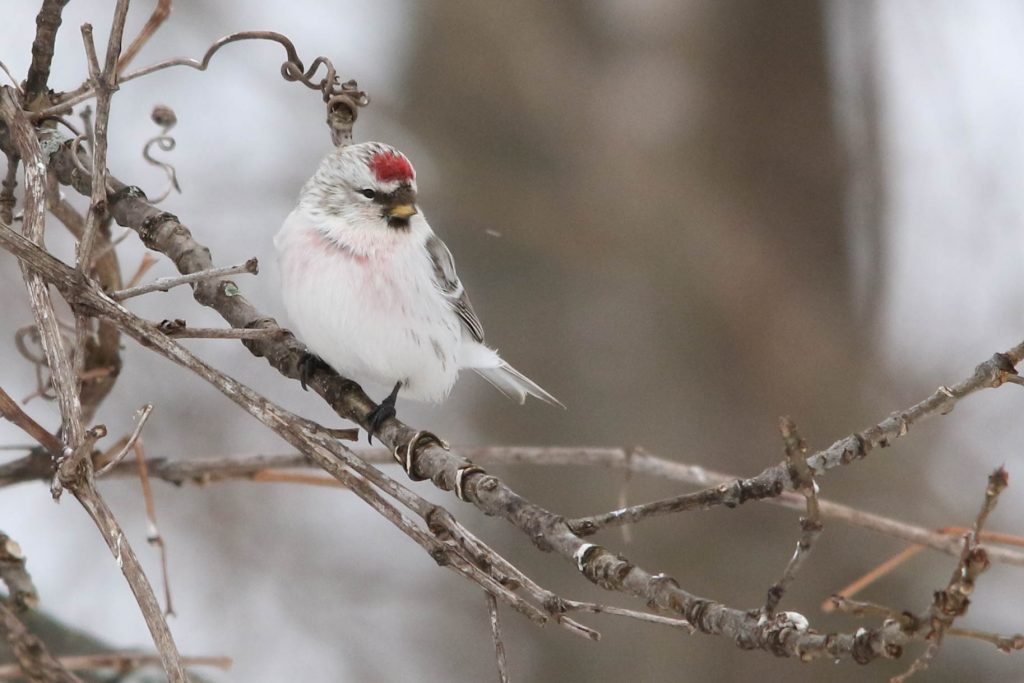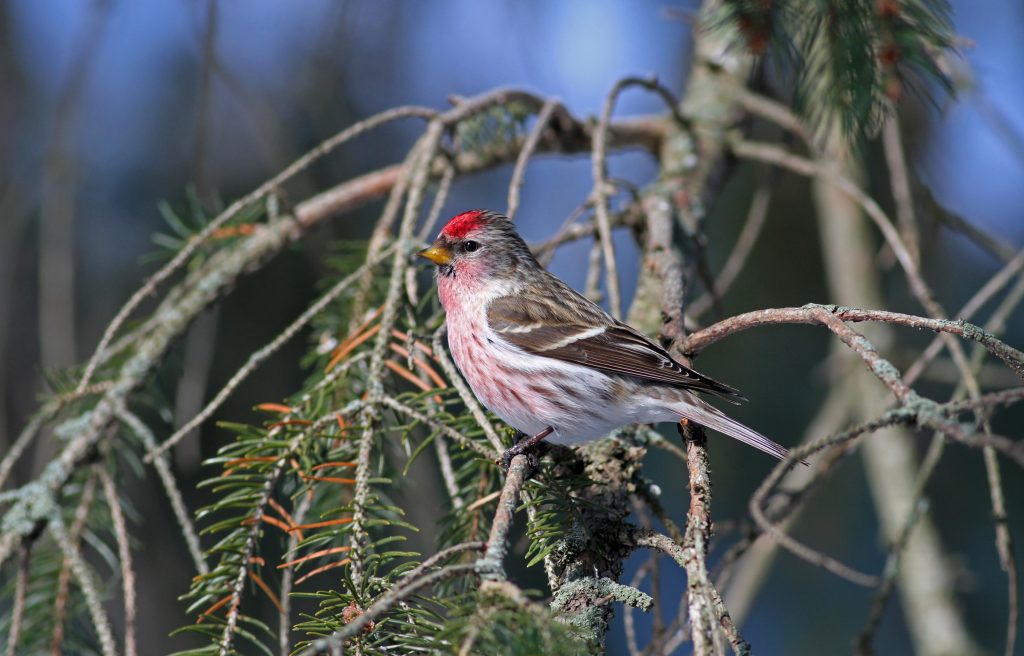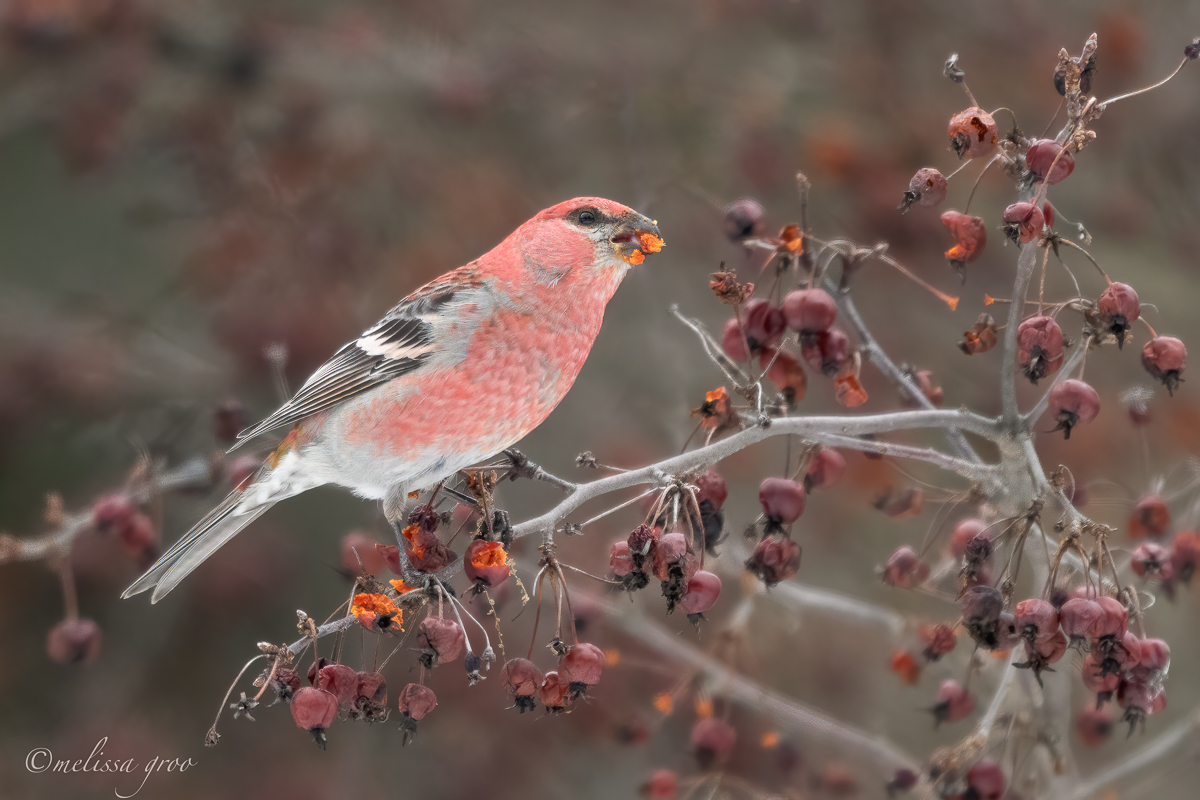By Tyler Hoar and Matthew A. Young:
As winter’s grip relaxes, the snow melts, the sun feels warmer, and Northern Cardinals, American Robins and House Finches are singing their first widespread songs across Eastern North America. On these last days of winter, the most northern, and last arriving of the winter finch species of the fall (i.e. Pine Grosbeaks and the redpolls), start their return trips. In this three-part winter finch forecast update that we’ll roll out over the next few weeks, we’ll give a view of how the winter finch migration will work in reverse.
Pine Grosbeak
In winters like this where its preferred food sources (Mountain ash species, winterberry, and other berry crops) in the eastern Boreal forest fail, Pine Grosbeaks irrupt southward looking for food. The Fall 2020 Pine Grosbeak irruption was modest to strong with higher numbers pouring out of Eastern Quebec into New England. Other than a couple outliers, the southern terminus of the Pine Grosbeak’s winter’s flight in the east was central Minnesota and Wisconsin, the upper part of the lower peninsula of Michigan, central New York, and northern Connecticut.

Pine Grosbeaks are the first winter finch to start its return home. Movements can be noticed the very last days of February with the main push northward seen between March 5- 15th. By the first week of April, most have returned to their breeding areas in central to northern Canada. However, after years of strong irruptions like this, a few loitering birds can still be seen in areas of northern New England. By May, most Pine Grosbeak reports are from either tardy lingering individuals in areas in the southern Boreal forest, Saint Lawrence valley in Quebec, or from southern breeding populations. These would very likely be immature birds.
Southern breeding populations of Pine Grosbeaks can be found occurring in parts of the Maritimes provinces, Northern Maine, south-central Ontario, and the Gaspe Region of Eastern Quebec. It’ll be interesting to see where the last remaining birds are seen, so please report lingering birds to eBird.
Hoary Redpolls
The Hoary Redpoll invasion in the east started out strong and has been the best one in close to 10 years or more. Reports of Hoary Redpolls have been confirmed as far south as New Jersey, Pennsylvania, Ohio, and Indiana, and a couple flocks in New York have held as many as a half dozen birds. Several have also been reported across Alberta and the southern boreal to the western Great Lakes.
The Hoary Redpoll will start moving back northward with Common Redpoll flocks in early March, but even into the first week of April and later, Hoary Redpoll individuals can linger from Northern Minnesota east through New England. After years of large irruptions like this, a very rare tardy individual can linger even into May along the southern edge of the Boreal forest in Southern Canada and Maine.

Common Redpolls
The Common Redpoll flight in the east has been the best flight in more than a decade. Reports have come in from as far south as, New Mexico, Oklahoma, Arkansas, Tennessee, and North Carolina. Like its close relative the Hoary Redpoll, the Common Redpoll will also start moving northward in early March from the southern edge of their irruption zone. The main movement northward is spread out over several weeks from mid-March to mid-April. Warmer early spring weather and/or heavy snow cover can affect local departures of this species. The snowpack can inhibit access to food sources such as weed seeds scattered on the ground.

After great irruption years like this, rare loitering individuals can still be seen into early May from the upper Midwest states east into Pennsylvania and Southern New England. Areas of Southern Canada, particularly the lower Saint Lawrence valley area of Quebec can still have small flocks into early May.
In summary, by mid April Pine Grosbeaks will have returned north, and redpoll fever will have died down to approximately 98.6 degrees. For now, keep feeders up and filled, document the last remaining birds in eBird, and enjoy the return flight of what has been a great finch winter.
Cover Photo Credit Melissa Groo
FiRN is a nonprofit, and has been granted 501c3 status. FiRN is committed to researching and protecting these birds and other threatened finch species like the Evening Grosbeak and Rosy-finches, and if you have been enjoying all the blogs and identifying of Red Crossbill call types, redpoll subspecies and green morph Pine Siskins FiRN has helped with, please think about supporting our efforts and making a small donation at the donate link below. We plan to support student research projects and more.
To Read more about Redpolls see the link below:
If you see sick finches at your feeders, please read the below article for instructions on what to do:

